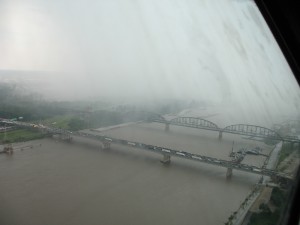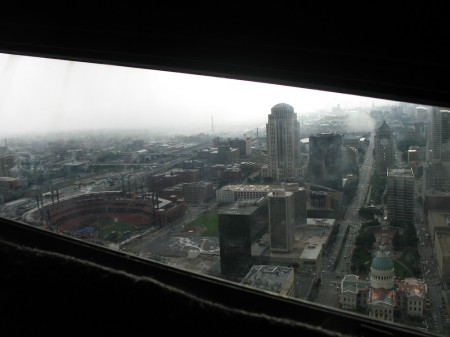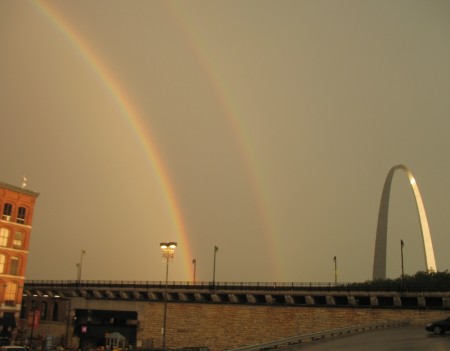I had not particularly wanted to go up into the St. Louis Arch myself, but the students really wanted to and we had a little time to spare after the Science Museum. So I grabbed tickets for the last tram to the top, and I’m glad I did. Looking down on the city and river from above you could, in an almost tactile way, reconcile the geographic elements with the history that we’d talked so much about at Anheuser-Busch.

Standing in line, waiting for the tram to the top, we were treated to a short documentary on the Eads Bridge, the first across the Mississippi in St. Louis. The video stressed the importance of the bridge in allowing the city to become the gateway for westward expansion.
The tram arrived and small rectangular doors opened up to reveal tiny escape pods fit for a spaceship. Five of us squeezed in, fortunately we were all friendly. The distinct possibility of claustrophobia tinged the air. Three minutes 47 seconds later we reached the top. Forty-five degree rain was pouring down outside. The wind was so strong you could, if you held still and waited for it, feel a slight sway in the Arch itself.


Looking east we saw the mighty Mississippi. Not quite so mighty as it is in Memphis, which is downstream of the confluence with the Ohio River, but enormous nonetheless. On the river, huge barges carried freight cars with unknown cargo south toward New Orleans. Just below, an helicopter sat on an helipad barge waiting for an emergency call. Directly across the water, on the east bank, enormous silos with their own docks waited to load barges with grain collected from across the mid-west.
It was still pouring when we left the Arch, and the rain continued on even during dinner. But leaving the restaurant, heading back to the hotel, the setting sun to the west, refracted through raindrops over the river, created one of nature’s own ephemeral monuments. A poignant reminder that forty-five, or even one hundred and forty-five years are but a moment in the deep span of geologic time.


